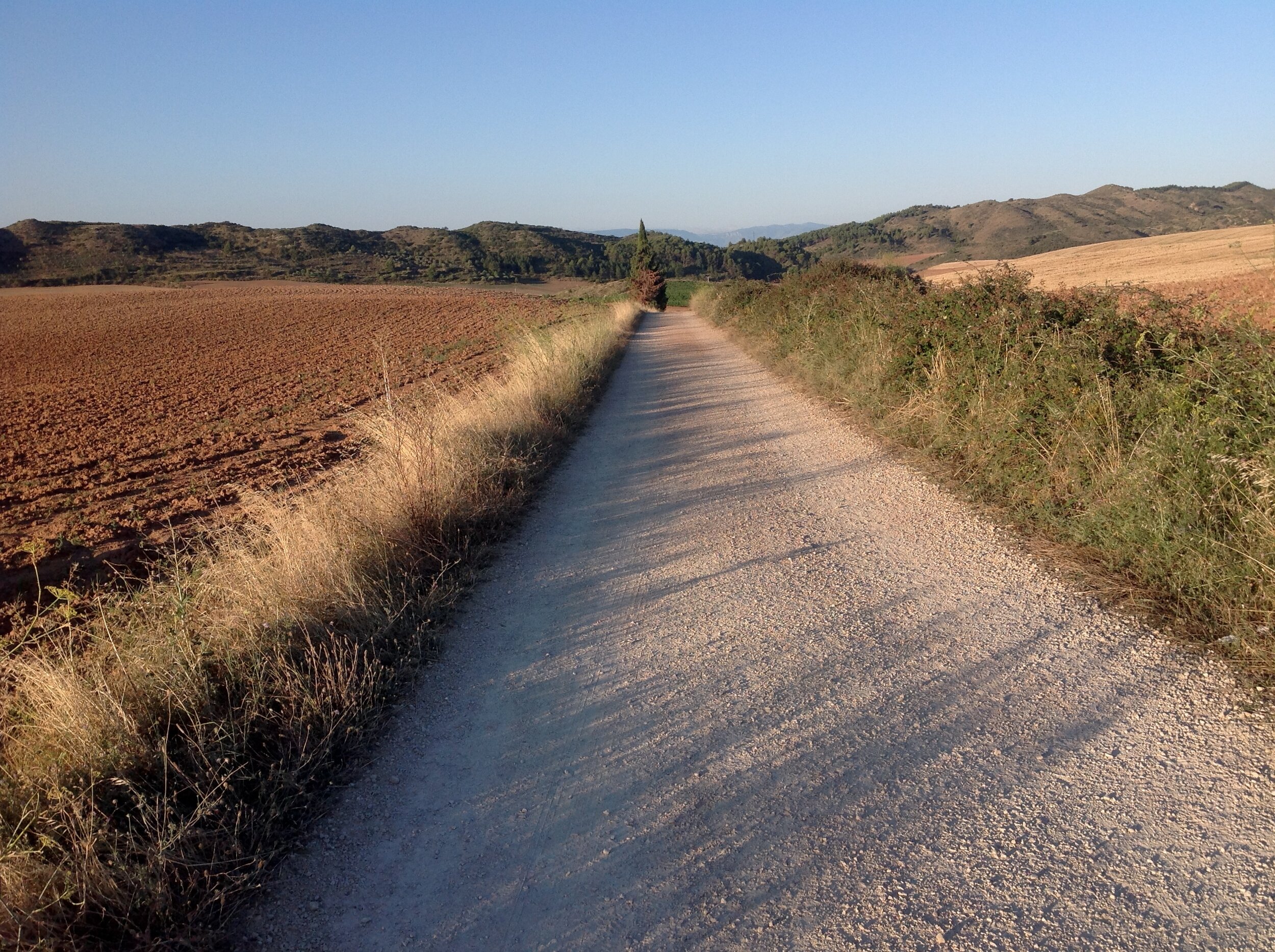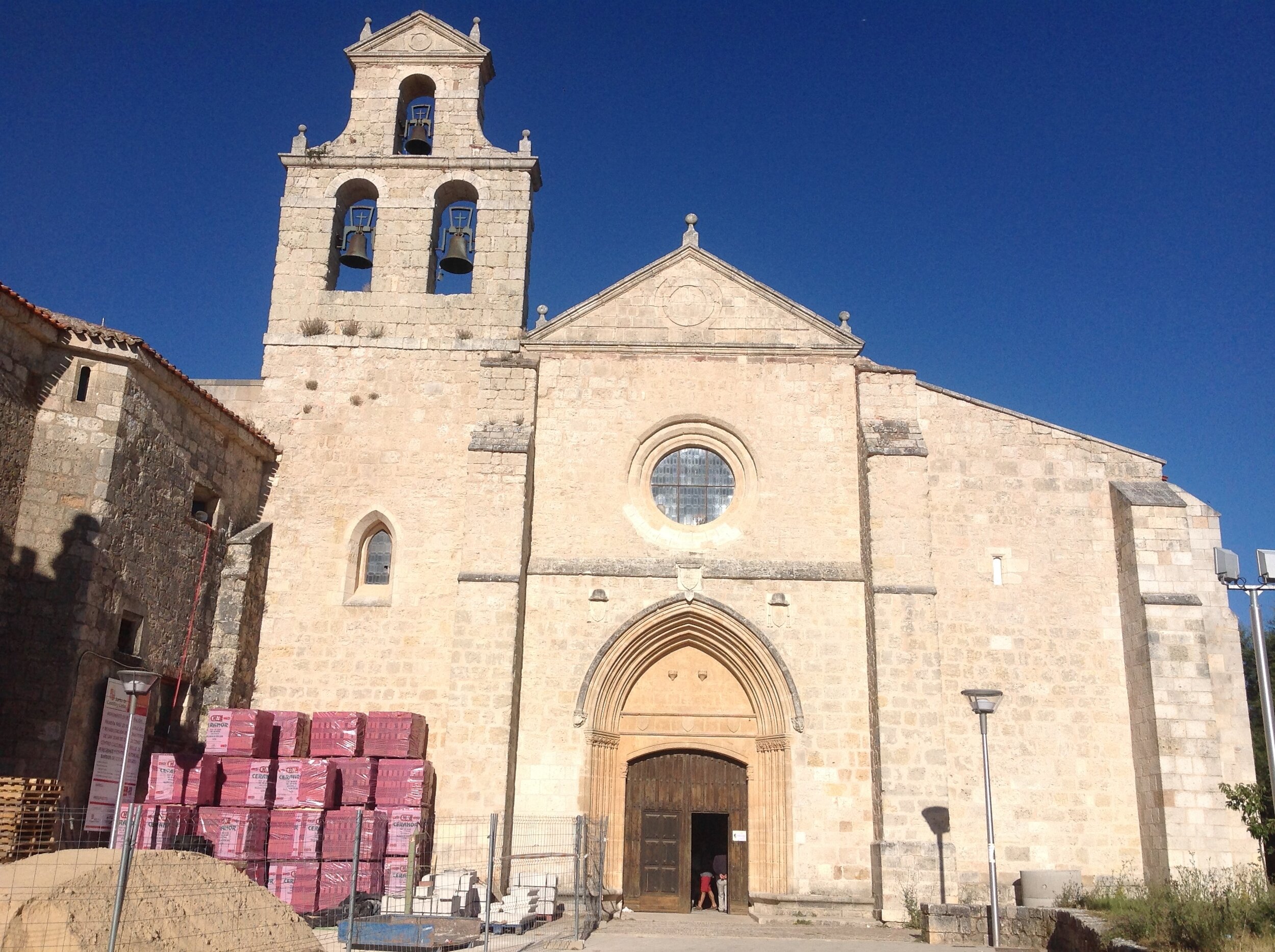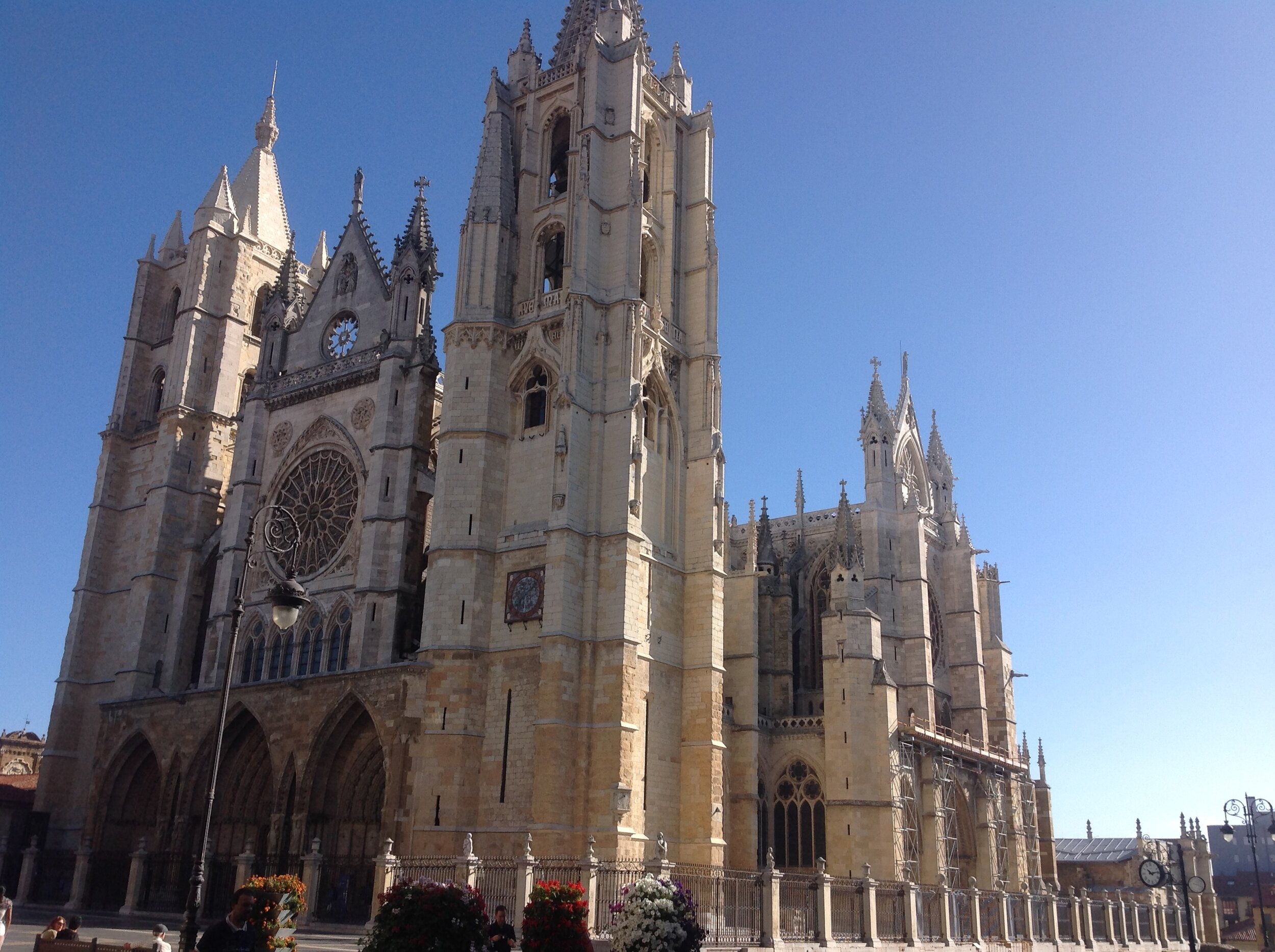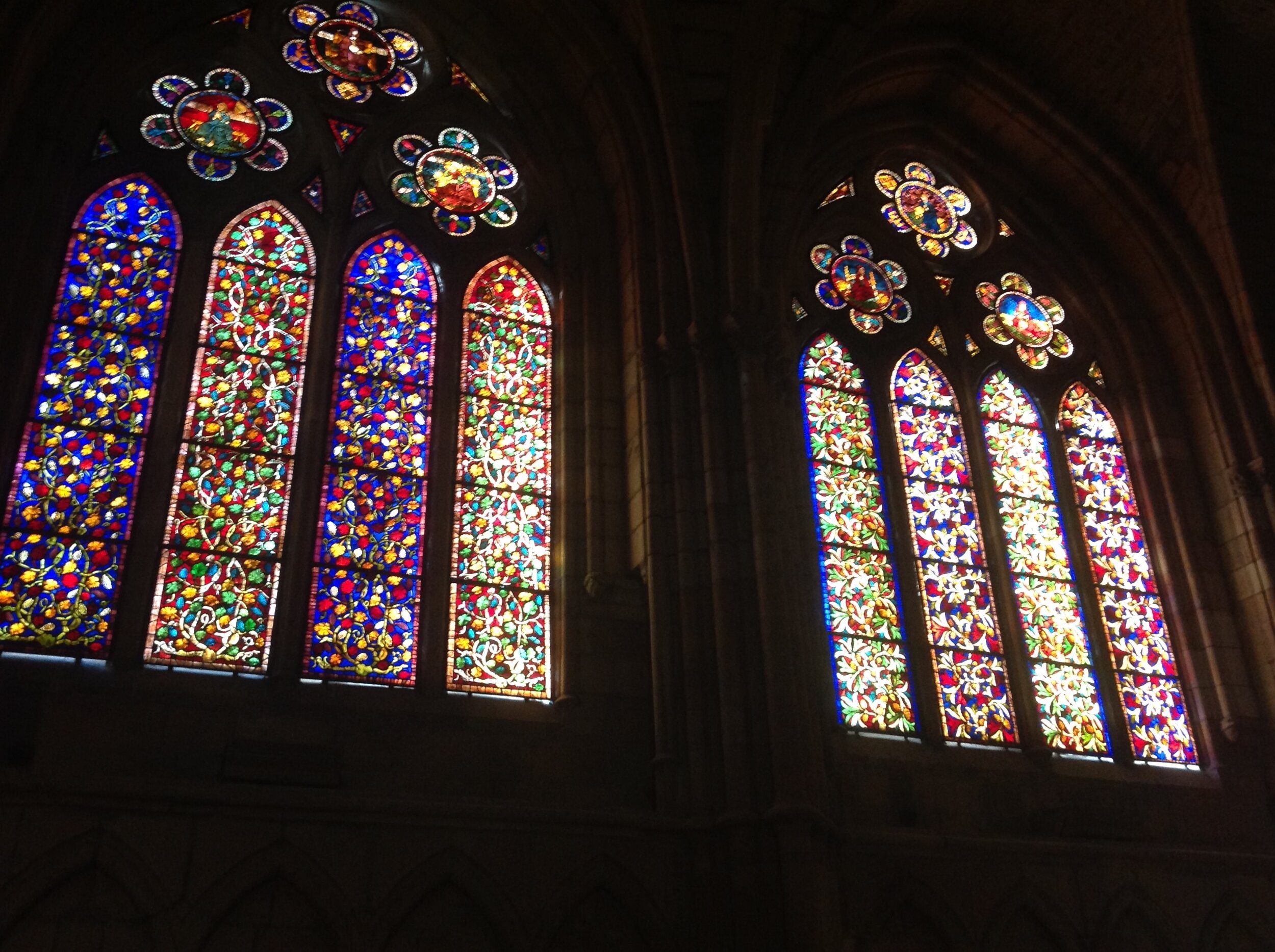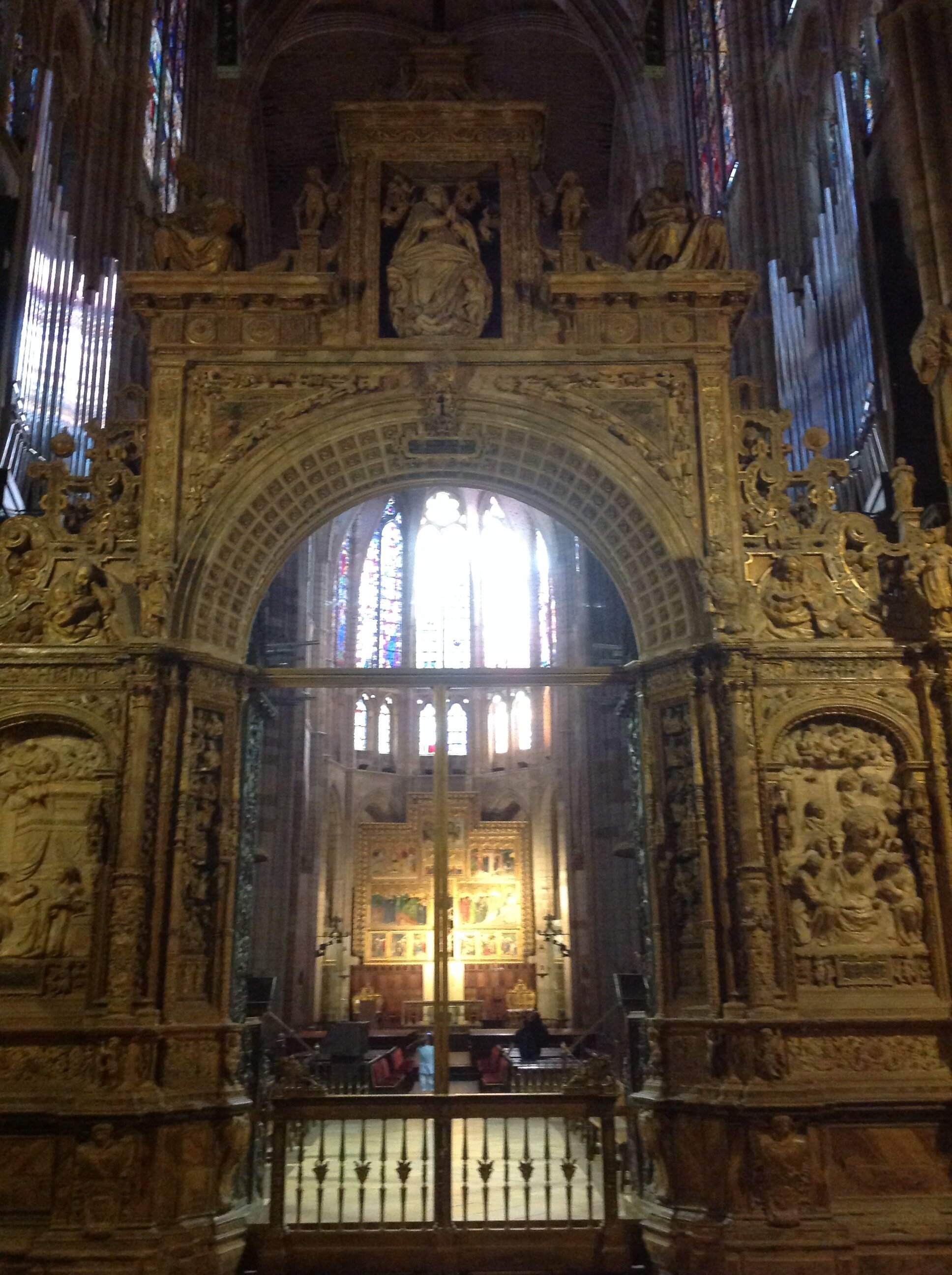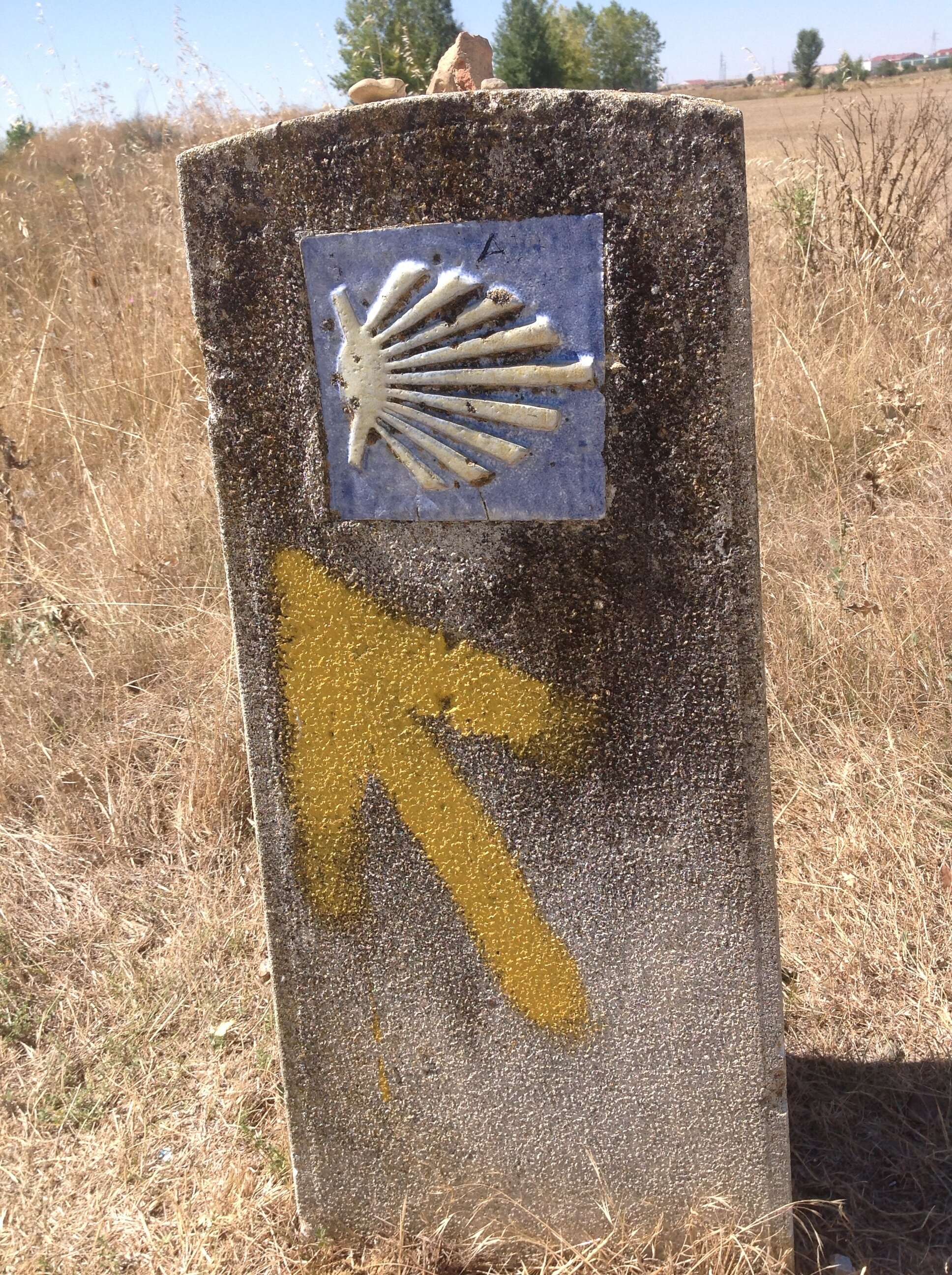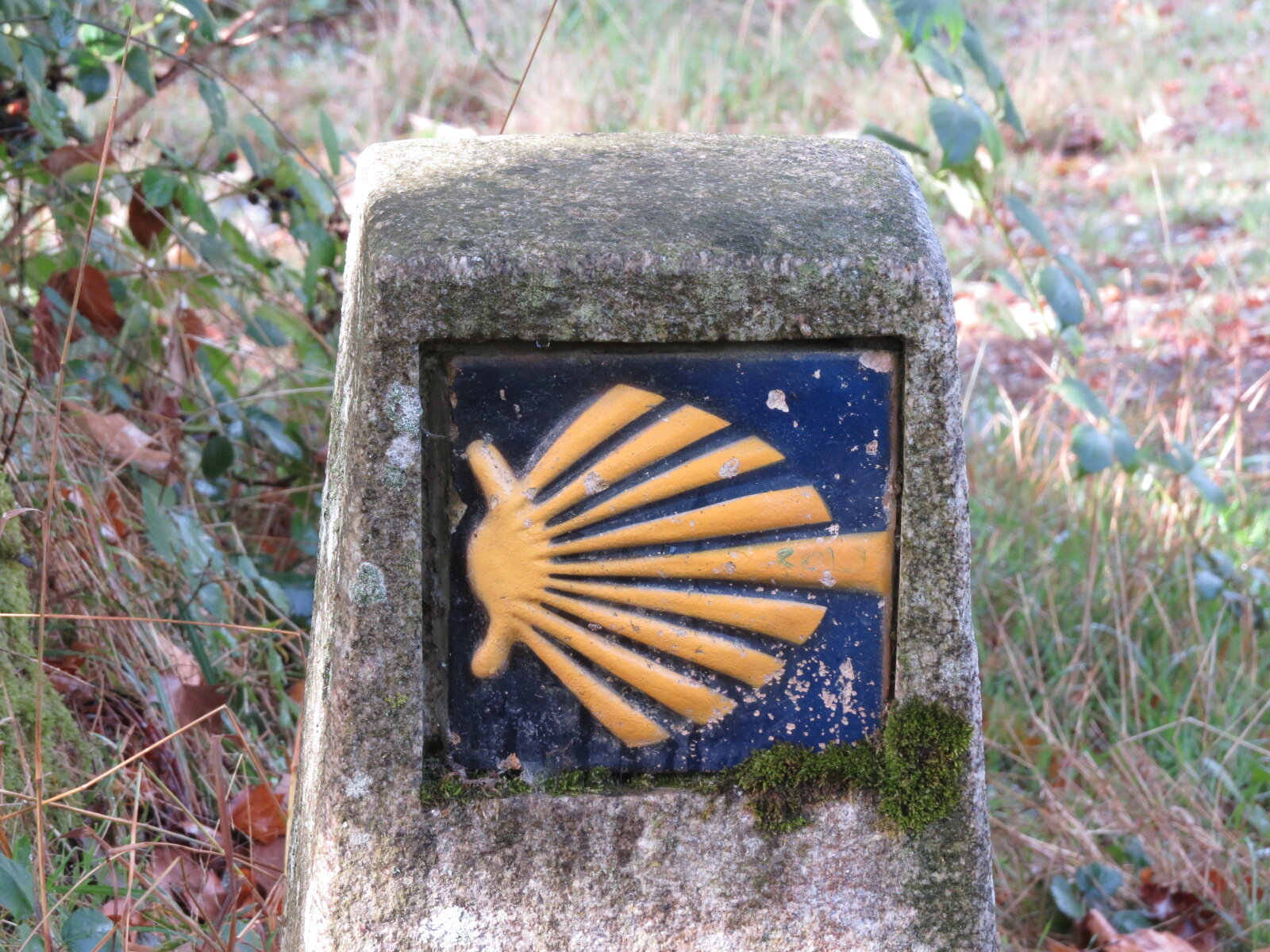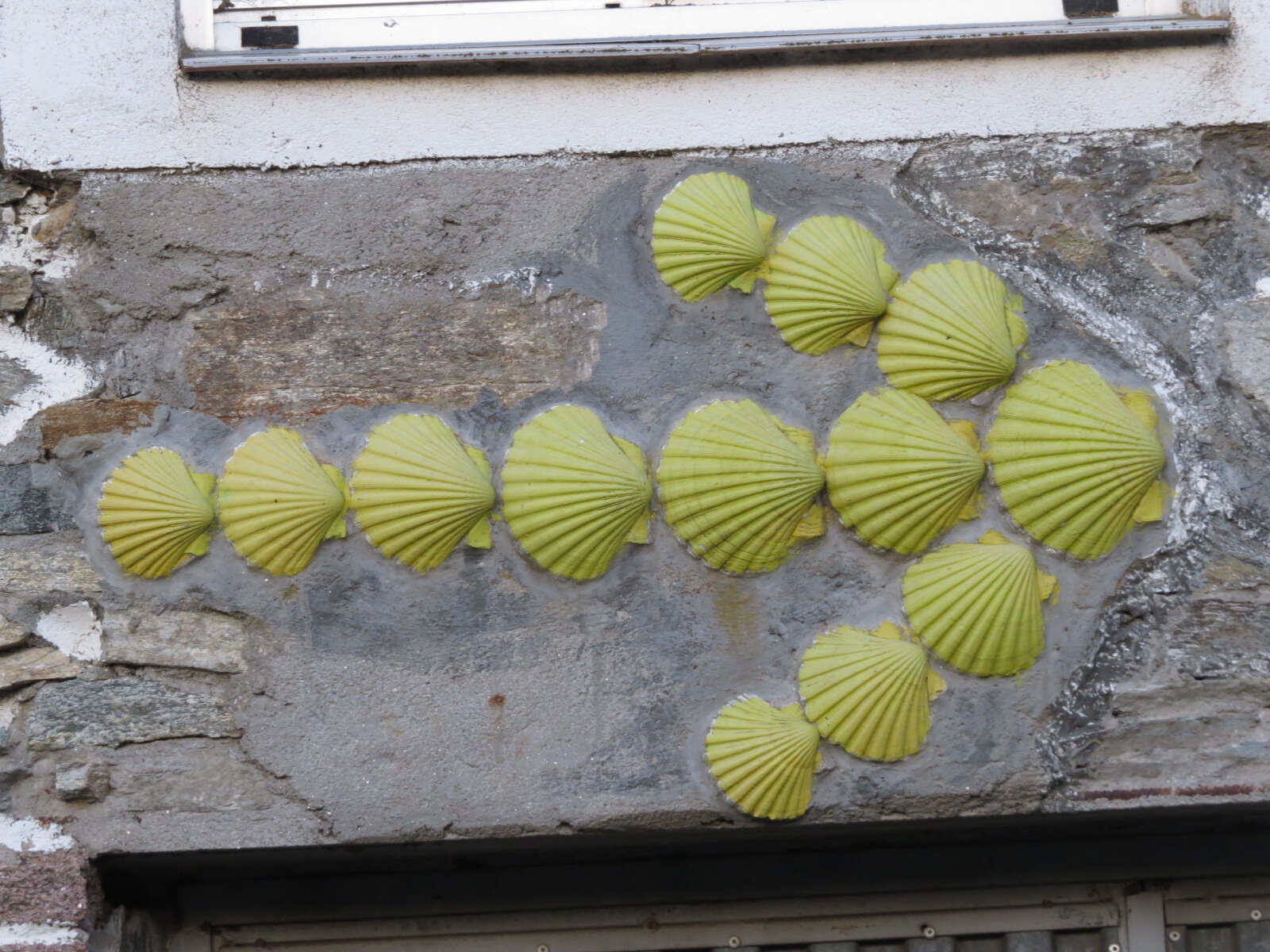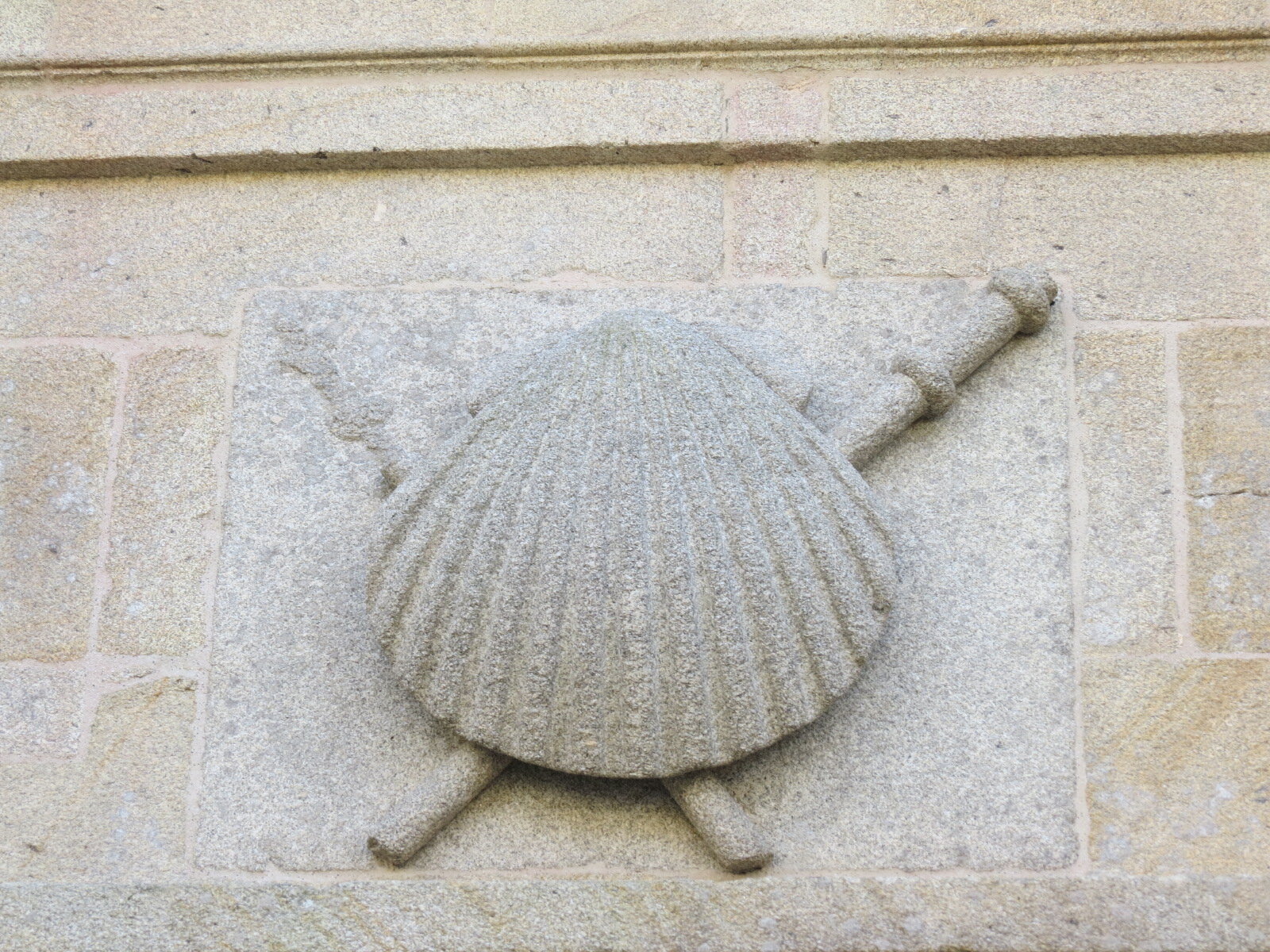“I found out that there’s a long distance trail in Spain,” Kees told me many years ago. “Do you want to walk it with me?” I thought that a historic walk through Spain would provide a chance for him to bond with his brother Rob, who was a professor of art history, so I suggested they walk it together.
Back in 1999, hardly anyone had heard of this 1,000 year old pilgrim’s path which runs from the border of France and Spain to the city of Santiago de Compostela in north western Spain, a distance of over 700 km, or about 450 miles. Both brothers started training and never stopped hiking again. In fact, Rob ended up hoisting his pack onto his back, closed his front door in Amsterdam and walked to Santiago - over 2000 kms in 16 weeks. Years later, Kees hiked the Camino for a second time. This is his account of walking that now very popular trail.
Kees: To qualify for an official certificate, you only need to walk the last 100 km on foot or 200 km by bike. It requires endurance to overcome the hardships of the full 700 kms - including sore legs, blisters and any inconvenience imaginable.
People have made this Catholic pilgrimage since the year 800. During the Middle Ages thousands walked it every year. It is said that walking the Camino will cut your time in hell in half. So I figured that if I hike it twice, I am scot free and will go straight to heaven.
After months of preparation I was ready to leave. Margriet will join me for the last 100 km (just to be sure she qualifies for half her time in hell). I start in Pamplona, the first city after the Pyrenees where the trail starts. The reason I start there is because the first couple of days coming down from the Pyrenees, are downhill and many poorly trained folks have to quit because of terrible shin splints.
I flew to Pamplona, Spain. En route, in Amsterdam, I met an old friend, Lisa, who was also on her way to hike the Camino. On our first day, we hiked, climbed and cursed our way though some of the hardest 14 km the Camino throws at you.
Day 2 started with dark clouds and a forecast of thunderstorms. We decided to take a chance and go for it. We tackled the hardest pass we would be facing on the first part of the Camino. I had trained a lot in hilly country but Lisa, living in The Netherlands, never had that opportunity and this obviously played a role in her falling behind quickly. However, she is a determined person and did eventually make it to the top of the pass and down on the other side.
We found a nice refugio in a village on the other side of the pass and stopped for the night. These refugios are like hostels, often with 20 or 40 people together, co-ed, in one large room in bunk beds. We had the first pick of the beds, but within a couple of hours the room filled up.
Refugios cost around 10 euros a day. A pilgrim’s menu is also from 10 to 15 euros, (CAD$15.- to 22.50). Not bad, although it does add up after 30 days on the trail.
A quick shower, washing sweaty quick-dry clothes, a beer, a nap followed by a meal – and we felt better. Lisa and I agreed that we would walk together for 2 or 3 days and then we would each find our own way to Santiago. I want some time to reflect by myself and be alone while walking.
There are many more hikers this second time around compared to my previous walk. Also, mountain bikes are now allowed on the trail, and not always considerate of hikers.
There are also many more refugios now, as well as hostels and hotels along the route. A good thing since sometime the walk turned into a race for a bed. The historic trail obviously is much more known and has become a multimillion dollar tourist attraction for Spain.
While day 3 was a ‘killer’ hike, day 4 was slightly easier. I found overnight accommodations in Villamayor, in a refugio run by a Dutch religious organization. We enjoyed a communal dinner there. I left late, at 8 AM, yet overtook several people within the first 2 hours who were struggling with blisters and sore legs. How will they ever will make the next 650 km? I like to start by 7 AM at the latest because by 9:30 the sun is already too hot to walk comfortably.
It’s quieter today. The first 2 days was weekend and obviously many Spaniards are walking the trail just for the weekend. There are more hills than I like, but that is Spain… My feet are not doing well, I rarely have a blister but in the first two days I have two. Even if I have to crawl the last 650 km I plan on making it! I’m averaging 20 kms a day right now.
I notice a lot more people speak English in Spain now, especially the owners of the new refugios. When Rob and I hiked it more than 20 years ago, nobody over 35 spoke any English and now I have not had a problem yet between their English, my few words of Spanish and a lot of hand gestures.
Dark clouds all around, but no rain. It helps to keep temperatures down. When the sun is out it easily gets up to 30ºC.
I am not following the official stages which are described in most guide books of the Camino. Those stages usually lead from town to town but I try to find smaller villages to stay in.
I left Lorca, half way between Puenta La Reina and Estella. Estella is famous for its beer, although I was there too early in the day to try it. Ten km past Estella I stopped in Villamayor de Monjardin after a tiring climb up a steep hill.
The next day via Los Arcos on to Torres del Rio. That was enough for the day because after that some steep up and downs await. I’ll leave those for early next morning when the weather is still cool.
The landscape is interesting, but not spectacular. More and more vineyards appear. The hills are primarily brown and yellow since there has not been much rain lately. There are few trees. Lots of ruins. Every village has a church or cathedral, often worth visiting.
When I left Torres del Rio, I immediately had to climb several steep hills to gain (and loose again) several hundred meters in elevation. By 1 pm I walked into Logrono and finished the first 100 km of the planned hike. Only 620 left!
Friday: It is a special holiday in Spain today and everybody is enjoying a day off. Fortunately stores and bars are open. I walked 20 km and by 1 PM found a refugio where I was welcomed by a very friendly nun who spoke excellent English. “Six euros for a bed, lights out by 10 and at 6 AM we wake you with music,” she told me. So at 6 in the morning, I woke to faint chanting. It gradually grew louder and louder and by 6:30 Gregorian chants were blasting throughout the refugio. I laid back in my sleeping bag and enjoyed the chanting for half an hour before I got up.
So why in the world would anyone want to walk 100 km – and many people walk 750 km – to a city for a look at a statue in a cathedral? That’s what I wondered years ago when I first learned about the Camino de Santiago.
An article in Readers’ Digest explained that Santiago is considered the third most important holy city in the world for Christians, after Rome and Jerusalem. Around the year 800 the bones of apostle James were discovered in the area. Ever since, Christians have been making a pilgrimage to the site. Of course a church was erected on the site - it became a cathedral of great beauty. During the Middle Ages millions of people made the pilgrimage. Considering the fact that the European population at that time was many times smaller than today’s population, it was quite remarkable that so many people made the pilgrimage. During the 18th and 19th century for some reason the pilgrimage became less well known. Not until the 1990’s did it again gain in popularity, primarily as the result of some articles in magazines and several books from people who had walked it.
By the mid 1990’s about 50,000 people walked the trail each year. However, by 1999 150,000 people hiked it because it was a holy year (this happens about every 10 years). By 2013 the annual number in a non-holy year had shot up to 150,000 and now in a holy year it is over 300,000. In 2019, not a holy year, alone 350,000 pilgrims made it to Santiago.
People walk for many reasons. I met a German lady who had just lost her entire family, husband and three children in a horrific car accident and she walked to figure out what to do with the rest of her life. I met a Brazilian lady who hiked it because she had read a book about it by a famous Brazilian writer. A Belgian man in his 80’s claimed to have walked it 18 times. A Japanese fellow said his minister told him he needed to do it to find himself. Unfortunately all he found were some robbers who took his money and camera. I ended up sending him copies of all my photos so he had at least some positive memories.
Many people just want to experience the culture and the history of the trail. And some, like myself, just do it because it’s a challenge. The Camino is easier than, for instance, the Continental Divide or Pacific Crest trail where you have to prearrange food drops and carry a tent because you cross wilderness. It is much easier than the Trans Canada trail. It is extremely well marked and you rarely wonder where the trail runs. Villages with food and accommodations are perfectly spaced along the path.
A few years ago about 55% of the pilgrims were male and 45% female. Many females walk it by themselves and it’s safe. 87% of people walk it, 12% do it on a bike and nowadays only 0.5% ride a horse. Even 0.03% have done the trail in a wheelchair (66 total in 2013).
How old are these pilgrims? 28% are under 30, 56% are between 30 and 60 and still 15% are over 60. That last statistic surprises me, because the number of people I have seen of my age or older I can count on two hands.
And where do they come from? Not surprisingly over 50% of pilgrims are from Spain, followed by Germany and Italy with 14% each, Portugal 10%, the US 9%, France 7% and 3% of the pilgrims on the trail are Canadian.
My feet are finally getting with the program and have stopped complaining about their daily mistreatment. Yesterday I did 32 km and today 23 without any problems.
I am impressed with the tremendous new infrastructure the Spanish people have developed over the last couple of decades. Brand new highways, new subdivisions, a whole new city (Ciruela) have sprung up in places where I saw raw land 15 years ago.
Also the infrastructure developed for the Camino is impressive. Where 15 years ago you had to walk on the edge of the highway, there are now separate pathways, adjacent to the highway, but protected by guard rails and vegetation. I suspect that the Camino is being developed and maintained by provincial departments. Many cities have gone out of their way to develop nice picnic sites, parks and campgrounds. Not everything is well maintained, but they are doing their best.
Today I walked into a new province: Castella y Leon, from La Rioja. After walking for more than a day past vineyards, a few sugar beet fields showed up and then grain fields, km after km of rolling grain fields, no end in sight. And today suddenly colorful, yellow sunflower fields.
I arrived in Belorado after a 23 km day which was a lot easier than the 32 km yesterday. In two days I expect to be in Burgos where I will take a day’s rest. The September weather is fantastic for hiking, 25-28 degrees, sun, but also clouds from time to time and a little wind to keep cool.
Many roads lead to Rome, so there are also many routes that lead to Santiago. Most pilgrims follow the common route: the Camino Frances. However 14% approach via the Camino Portugues. The remainder uses one of 9 or 10 other routes leading through Spain to Santiago.
I just sit down for a late lunch and before I even notice it, an open bottle of red wine and a glass are put in front of me. No questions asked about what I want. This is what you drink with your lunch here. Fortunately I have already made my bed in the refugio next door and can sleep off my early drink during a siesta.
After leaving Burgos, the trail ascends onto the meseta over which I will walk almost the entire next week. It is a high plateau, ranging between 800 meters and 1100 meters. Walking across the top of the table mountain is fine, but hiking up it is a 12% incline. Coming down at 18% is equally hard and tiring. However the views across the top go on for ever. Fortunately there is a little wind that makes it quite pleasant. Most villages on the meseta are located in a fold of the terrain so you always hike down into them and after a drink or lunch it’s back to the top of the meseta.
Spaniards love hunting and the result is that I have not seen a live animal expect cats and dogs. No birds in the sky except a few wrens in the cities or swallows around a church. Not a deer, rabbit or anything else in the fields or forest. Especially on weekends you constantly hear gun shots. Not long ago I was hiking in Andalusia, in southern Spain, and thought I noticed evidence of wild boars. But I was told the turned up soil was the result of farmers and trained pigs looking for truffles. It is eerily quiet as you walk, no birds in the sky, no movement in the fields.
On weekends there is a noticeable increase in cyclists. When I walked into Burgos, I noticed a ‘pilgrim’ getting on a city bus to take her from the edge of town to downtown. It was not a pretty part of the hike, 1 1/2 hour of walking through traffic and an industrial area, but taking the bus should not really be part of hiking the Camino in my opinion.
A refugio
One of the biggest recent changes I see are the forests of huge windmills. Just like in other places in the world, Spain is building huge windmill parks to generate power. Smart way to go, but it sure scars the landscape of the countryside.
Three days ago I lost a sock, it took me days to find a sports store that sold the kind of socks I want. Finally this morning I managed to buy a new pair of socks. A few hours later I slide into my sleeping bag and what do I feel in the bottom of the bag but the lost sock! Now I have an extra pair.
When I left Burgos I felt energetic and hiked 30 KM, ending up in a quiet village called Hontanas. This morning I did not feel as energetic and only did 20 km, so now I am in Itero de la Vega, population 190.
For almost a week since leaving Burgos I walked on the meseta, straight roads, flat high country with few trees in sight and mile after mile of grain fields. Pretty monotonous and boring.
Much of the time I walk along on a path skirting the road. Not bad with firm gravel, but also sharp rocks from time to time. Today I saw a doctor about a huge blister but she just shrugged and sent me on my way.
Last night I sat on a plaza and watched the locals do their thing. Young boys playing soccer, old folks visiting on a bench where they’ve probably sat for years, couples in love sauntering from one end to the other around the plaza.
A grainery.
I stayed at an albergue (refugio) in an old church, nicely renovated and with a fair amount of privacy which is something few albergues offer. In the middle of the night there was a terrific bang that seemed to shake the whole place. Someone fell out of the top bunk in his sleep! I learned a few new Spanish curse words.
I met a Canadian couple from Nova Scotia who, at diner time in a refugio, made a stew of all kind of vegetables and sausages. They invited eight other peregrinos so I brought a couple of bottles of wine. We had a great time conversing in English, Spanish and French as well as sign language. Unfortunately they had left very hot peppers in the stew too long and the poor soul who had stew from the bottom of the pan spit flames after a few bites. Even half a bottle of wine did not put him at ease.
Leon is half way between Pamplona and Santiago. Time for a few days of rest so my feet can get back to normal. Found a cheap little hostel next to the cathedral, which has the largest expanse of stained glass of any medieval cathedral in Europe, absolutely beautiful with the sun shining through.
I attended a pilgrims’ mass. Didn’t understand a word, but the atmosphere and singing was nice to just sit back and let it come over you.
Judging by my guide book the rest of ‘The Way’ should get more interesting after a rather boring week on the meseta, as well as harder. The elevation maps are showing some rather high hills in my near future.
My guide is good as far as info about refugios and elevations. Other than that it is useless to find your way. However the trail itself is so well marked that you can find it without too much of a problem the entire way. Lots of signs with the well known camino emblem, a St. James shell, show ‘the way’. There are also arrows on buildings, on corners, on the road itself, on curbs and anywhere you look.
It seems impossible to get lost unless you are not paying attention. It is starting to get busier because several other caminos join the main trail. Also numerous people start their walk somewhere along the trail at Burgos or Leon.
I think that after 50 years I may have discovered that I can slow down! Ever since high school I was urged to be very competitive: first my PE teacher, then my speed skating instructor, then two years of sports college and two years teaching PE in the army. Always I had to be the first, the fastest, the quickest, the highest jumper. Even when I trained for the Camino I walked fast, at least 5.7 km per hour. As a result, when I walked the first half of the Camino, I seemed to be marching instead of walking. That too may have resulted in the injury that caused me to have to sit down for several days in Leon.
So today I decided to take it s-l-o-w, and what a difference it made. It took me longer to get where I wanted to go, of course, but I noticed much more of the surrounding area. I did not pass every pilgrim in front of me as I had done for the first 350 km. As a matter of fact I was being passed and I did not mind it for once. My previous injury did not come back because I did not need to push off as hard as I used to do with each step.
I left Leon after 3 days of forced recovery. First 2 hours to get out of town and then back up onto the meseta. Because most people only spent one extra day in Leon, I moved now with a new “community of people”. The ones I had seen several times in refugios or rest places before Leon were replaced with a new bunch. You could tell who started the Camino in Leon because their legs were still white, while those who had been on the Camino for weeks were tanned. In spite of slowing down I did 22 km by noon and arrived in a nice albergue in Villar de Mazarife.
Two days out of Leon I arrived in Astorga, one of the typical, cute Spanish towns in north western Spain. Since I was ahead of schedule I decided to stay an extra day and found a little hotel on the edge of town. I explored the city and then discovered that I was extremely lucky to have decided to stay. I was having dinner on the edge of a large plaza when someone stopped in the middle of the plaza and installed a sound system.
Within an hour hundreds of chairs were set up and people arrived from all sides. It turned into a huge dance festival that lasted the entire evening. What a shame that I did not have my camera with me. Beautiful traditional clothing was worn by the participants, exciting Spanish music with dances on the stage all evening. How lucky I was!
After Astorga the terrain changed, becoming more interesting, hilly, more greenery, more small scale farming and more pictoresque villages: Rabanal, Molinaseca, Villagranca, and finally Sarria.
The steeper terrain made for more difficult hiking, through villages where herds of cows, sheep and goats moved through the streets with the resulting slippery surfaces.
Galicia is my favourite province with gorgeous views down valleys and across hills high enough to be called mountains. Until the day before Sarria the weather was great. Only the last day I got soaking wet, six hours of rain.
Sometimes the food is good, sometimes not so much. Last night I had a terrific pizza in an Italian restaurant, a few nights earlier I looked forward to pizza which was advertised on a large sign out front of a restaurant, but turned out to be frozen pizza warmed up in the microwave, what a disappointment.
A few days ago I walked up to one of the highest points on the Camino: La Cruz de Ferra, an enormous pile of rocks created by pilgrims. You are supposed to bring a stone from your home area and leave it on the top of this mountain. This tradition was started around the year 1000 by a monk named Gaucelmo. He erected a cross on the site that was an original altar built by the Romans for their god Mercury. Since the 11th century every pilgrim, and there have been many millions, brought a stone to add to the pile which over the centuries, has continued to grow. Several months ago my grandson Nico gave me a rock he picked up from the beach when we were out walking. I told him I would take it with me to Spain to put in a special place. And I did. And made my wish as I added it, another tradition.
In Sarria I found a bookstore with a few English books and a cheap hostel where I can stay this week, until Margriet arrives.
“Buen Camino!” is what every pilgrim wishes others on the trail. It sounds like ‘BON CAMINO’. I don’t speak Spanish but by now I recognize things on the menu and can make myself understood.
Sarria is the starting point of the Camino for about 25% of the people who walk it. The town looks a bit overrun by people who seem unprepared for the 100 km hike. Either they have huge packs, or no packs and use a taxi or ‘porter’ service to have their luggage moved to the next place. Four elderly people from Australia admitted that they rarely had walked more than 15 km a day and never for a whole week every day. You just hope that they don’t get themselves into trouble.
Margriet: “How hard can a week be?” I thought. Kees had talked about walking the Camino again ever since he did it years ago for the first time. Five weeks of walking with a heavy backpack, day in, day out, is not exactly my cup of tea but I thought it would be fun to experience the last week of reaching Santiago together. I wanted to encourage him to do it. “Go!” I said. I had good hiking shoes and walked on them much at home, into town and whenever I went for a hike. I took the bare minimum so my pack wasn’t terribly heavy. But oh.. The slogging wasn’t easy. Up hill, along muddy paths… I did 112 Km in a week. Compare that to the 720 Kees completed. And he faced real mountain ranges, and heat, lonely plateaus and cities. I just trudged through tiny villages and cool forests. A couple of days of rain but also blue sky and sunshine.
It is always interesting to me to notice tiny little cultural differences in countries. Nothing earth shattering but interesting nonetheless. In Spain that includes pillows. In a double bed, there is one long pillow for two people. Why not two smaller ones so that you can each stomp and pummel and turn your pillow.
Torte de Santiago
The menu de diaz, day menu, for hikers along the Camino, is also interesting. For 8 or 10 euros you get to choose from one appetizer: soup, salad (a very large mixed salad) or a large plate of pasta. After this comes the main plate: usually very pale fries, a very flat piece of pork or chicken or a piece of beef. No vegetables. Dessert is cake, pudding or ice cream. The meal also comes with large, dry chunks of bread. No butter. And a glass of wine or water. Along the Camino, the specialty is Cake de Santiago: a fairly dry but tasty almond cake. I find it interesting that we can’t get bacon and eggs for breakfast but you can for every other meal. Lunch is often bacon and eggs with bread. And hamburgers have a big fried egg on top of the meat. Most meat dinners also come with fried eggs. But breakfast is mostly bread and jam or a croissant. I was surprised to learn that a ‘tortilla’ is not at all the Mexican tortilla we know in North America. A tortilla here is an omelette. A tortilla quaso is a wonderful, soft cheese omelette.
The villages through which we pass are tiny, sometimes not more than 2 or 3 houses and a barn. Many citizens living along the Camino have realized the pot of gold in their backyard. They have put plastic chairs out and offer coffee or lunch. They must make a bundle because the stream of pilgrims seems endless. People from all over the world hobble along, carrying packs and nursing their feet. Many have joined the Camino in Sarria, like I did. But the real ones come from much farther away – like Kees who passed the 700 KM mark today. There’s no way I would do that…
We’re picking up Spanish words as we go and can order meals, ask for a room, etc. I enjoy seeing the farm yards as we pass. Flowers like fuchsias, hydrangias, sunflowers. And vegetables like zucchini, pumpkins, Brussel sprouts, kale, carrots and potatoes are in abundance. We pass under grape vines in small villages and hear roosters crowing. Once in a while a farmer leads his cows down the road or we let a flock of sheep pass. We do a lot of slip sliding on cobblestones…
And then we arrived in Santiago. Suddenly there are major highways and city suburbs. We walk through the outskirts into the old heart of the city. More and more pilgrims congregate here. Blue sky and sunshine make for a glorious last day. We reach the Cathedral – an emotional moment.
We did it. Tomorrow we pick up our certificates as we show the many stamps we collected along the way in our pilgrims’ passports. For now, we drink a glass of wine to our accomplishments.
Kees: When I started the Camino I wondered if I would enjoy it this second time around. Now that I have completed it and had time to reflect I say a resounding YES.
It was different this time around, many more hikers, but also much more infrastructure to support the pilgrims. The last week of the hike it was so busy that at times it felt like I was walking down the the Kalverstraat in Amsterdam or Robson Street in Vancouver.
It seems that the entire world has descended on the Camino. However, back in the countryside it was still the same experience of solitude, sometimes loneliness, one of simplicity and peacefulness. At times I was very tired, but also satisfied that I had completed another section. Sometimes there was boredom because the terrain was not very interesting. Other times it was awe inspiring because the skies or the landscape were so fantastic.
Sometimes it was the people you meet, or the fact that you didn’t talk to a soul for twelve hours. It is so different from what we are used to in daily life; always different, exiting and challenging. So would I do it again? YES! Hope to see you on a trail somewhere!
For Books click HERE (then scroll down to Spain)
Websites: http://santiago-compostela.net
https://www.caminoguidebook.com/plan/budgeting
Movies:
• The Way with Martin Sheen (https://www.imdb.com/title/tt1441912/) This is a fictional, although fairly realistic, story.
• Walking The Camino is a great nonfiction documentary about different people walking for different reasons: https://www.youtube.com/watch?v=pJDxD_UE4ZQ
• I’ll Push You: https://www.illpushyou.com

